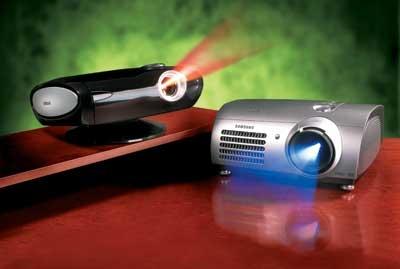Shootout: Eight Budget HDTV Projectors

| |||||||||
|
Two of the projectors we tested, from Hitachi and Panasonic, use LCD display technology, while the rest employ Texas Instruments' Digital Light Processing (DLP). Only in the last year have high-def DLPs fallen below the $2,500 mark, and the sudden surge of affordable models means even more choices for consumers seeking the ultimate home cinema experience.
If a front projector is in your future, here are a few things to keep in mind:
LOOK FOR AT LEAST 720P RESOLUTION. These eight projectors all have specifications of 1,280 x 720 (designated 720p) or 1,280 x 768 pixels, which is enough to make both DVD and full HD sources look great. If you're serious about watching movies and sports, avoid lower-resolution or non-widescreen projectors.
INSIST ON A DIGITAL VIDEO INPUT. You'll need a digital connection, namely DVI with HDCP (high-definition copy protection) or HDMI, to guarantee full compatibility with future high-def disc formats like HD DVD and Blu-ray. Also, nearly all of the units I tested exhibited a better picture through their digital jacks.
PERMANENT OR PORTABLE? The ceiling is the best place to permanently mount a projector. But if you're storing your projector between showings or carting it around, look for a compact model with a long zoom and "lens shift," which let you easily adjust image size and position for more flexible placement.
CONTROL THE LIGHT. Plan on closing the blinds, watching at night, and generally controlling ambient light any way you can. The darker you can get your room, the better the projected image will look - and pitch black, just like in a movie theater, is best. If you don't want to go through the hassle of darkening a room, then a front projector probably isn't for you.
I used test instruments to tune each of our eight projectors for the best image quality before assessing the picture on an 80-inch Stewart GrayHawk screen (with test patterns as well as DVD and HDTV program material). I looked primarily at three criteria. In the CONTRAST sections, I discuss image brightness, the projector's ability to recreate a realistic black, and how well the picture shows difficult details in shadows. COLOR refers to how natural and accurate colors are, as well, the projector's ability to track an industry-standard color of gray from black to full-on white without introducing hints of other unwanted colors - something we call "grayscale tracking." And I looked at each projector's ability to reproduce all the DETAIL inherent in DVD and HDTV source signals. I was also keeping an eye on picture uniformity - the picture's consistency and lack of artifacts across the entire screen image.
Brief write-ups on the projectors follow (alphabetically), as well as my picks for the best performers and best values in the group and complete lab data.
- Log in or register to post comments




















































